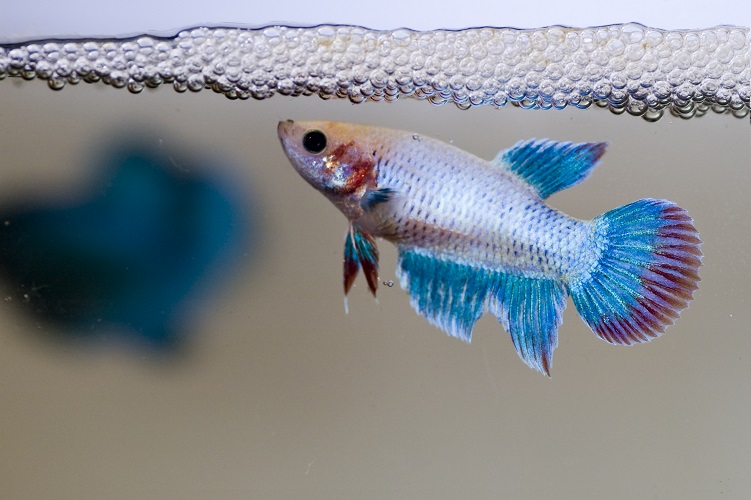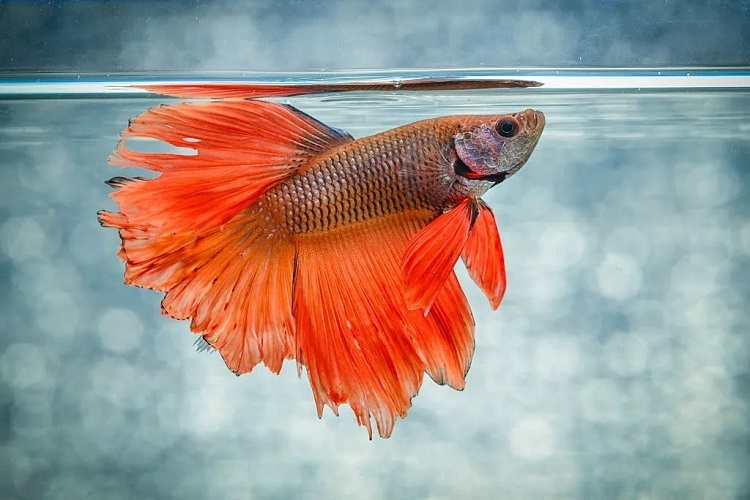Siamese fighting fish, a type of native Southeast Asian fish, is often an essential part of any fish lover’s aquarium. In addition to its historical past, the anatomy of the Betta is unquestionably the most intriguing aspect.
If you already own one or plan on buying a Betta fish for your tank, the following guide is just for you.
We’ll go through the anatomy of a male and a female Betta fish to help you understand more about these beautiful (but often scary) little creatures. Let’s go!
Contents
External Betta Fish Body Parts
The primary external anatomy of your pet Betta includes parts that perform swimming, fighting, mating, eating, supporting the body underwater, and much more.
Let’s start with the essential external part, i.e., their mouth, and move forward, covering the rest of the body.
Mouth And Teeth

Betta mouths and teeth are relatively diverse in form and function. Bettas have a highly sharp set of tiny teeth that enables them to chew and chomp down even the toughest meats. Their sharp teeth can jeopardize the rest of the tank members, as they are well known for nipping other fish’s tails.
The upward face is the main reason your Bettas usually look grumpy or have a constant smug look. However, these upward-angled lips perform the primary functions of inhaling the air, building bubble nests, and consuming food settled on the water’s surface without extra pressure.
Apart from chewing down the food, their mouths play an even more critical role in reproduction. Once the females deposit their eggs at the bottom of the tank, the male Bettas are responsible for carrying them in their mouths for a safe and secure environment. They should then move these eggs to the surface, where the eggs rest in their bubble nest for the later stages of development.
Body

Betta’s body exterior is made of fish scales that usually measure 2.5 to 3 inches in length. Any healthy Betta in captivity shall exhibit shiny scales with vibrant color schema.
However, like every fish, their scale-embedded body is susceptible to wounds, nicks, and cuts from fights or stumbling into sharp aquarium objects.
Females in stress display horizontal lines that always run down their bodies. Baby Bettas usually have these lines during their early stages of development, so owners must not worry if they spot such lines on their tiny bodies.
Eyes

Bettas have excellent eyesight, spotting even the tiniest details in their aquarium environment. The eyeball placement is similar to other fish in the underwater kingdom, which helps them see color and reflection despite the absence of eyelids or the ability to blink.
Since their vision is sharp, they tend to react to their reflection or any sudden movement outside the tank. Bettas’ iris is always black, but the outer rim varies according to the fish’s genetic pool and ancestry.
Scientists believe that Bettas, on average, can face nearsightedness as their acute vision only helps up to 12-13 inches. Their overall good eyesight aids them in hurrying up to the top of the tank whenever their owner puts something near the water’s surface.
Gills

Despite having a very uncommon labyrinth organ that helps with oxygenation, they additionally possess gills that are used to extract the oxygen from the water.
These tiny colorful fish can also intake the water in their mouth and pass it over to their gills for extra oxygen. These numerous ways are beneficial and come in handy in environments with comparatively low oxygen levels.
Operculum
Their operculum has the sole job of shielding and protecting their sensitive gills. Since gill tissues are extremely fragile and highly susceptible to damage, the operculum performs the function of a safety cover.
Male Bettas’ operculum protrudes a lot outward compared to the female Bettas. This operculum also covers the ‘Betta beard,’ a membrane visible in all-male subgroups. When these Bettas are in fight mode, they tend to flare the gill covers to appear scarier and dominant.
Fins

The Dorsal fin located at the top back of the Betta is used to primarily stabilize themselves in the water and help them turn as the fish follows a particular trajectory. Without these dorsal fins, the Bettas might struggle to travel in a straight line, affecting their hunting chances.
The next set is called the Caudal fin or most commonly known as the tail fin. Your pet Bettas use these fins for propulsion, and we use these fins to determine the breed. The most loved caudal fin Bettas include the Delta tail, Double tail, and Halfmoon, which are very different and unique from one another.
Pet enthusiasts must pay attention to the fin’s webbing as those parts usually exhibit signs of deterioration during fin rot. Other necessary fins include the anal, pectoral, and ventral fins, all required for propulsion and navigation.
Internal Betta Fish Body Parts
The following are some essential internal organs that help Bettas function swimmingly. We suggest owners learn about their internal organs to help ease their pain in cases of unexpected injuries.
Esophagus

Like humans, the air, water, and food travel through the esophagus, which is attached to the fish’s mouth. Any little injury while eating sharp pieces of food chunks can directly affect their esophagus, so owners must be very particular about their Bettas’ food.
Gill Arch
All Betta fish, irrespective of their breed, have a gill-arch that connects gill filaments and the gill rakers. This gill-arch is a muscular cartilaginous arch or curved bar structure that supports the gills. The oxygen goes through the gill arch to the esophagus and passes down to the labyrinth.
Labyrinth

As mentioned above, the labyrinth is undoubtedly one of the most intriguing organs of the Betta fish anatomy. All fish species in the early decades lacked a labyrinth; it later developed amongst the species living in slow-moving and stagnant less-oxygenated habitats.
The labyrinth allows the Bettas to gulp the oxygen from the top of the tank directly into their bloodstreams. As Bettas have a funny functional labyrinth, they are classified as anabantoids.
Similarly, fish relying solely on external gills to take oxygen do not fit into the anabantoids category. Because of this organ, your Bettas can easily survive in tanks that do not have a bubbler or oxygen filter.
Still, installing a bubbler for safe and comfortable living conditions is always a good idea. If for some reason, your bubbler breaks, skim the water from the surface level, so the fish have some space to take up the oxygen from the air.
Liver

The liver of a Betta fish assists them in storing and processing nutrients throughout the body. This liver secretes a particular enzyme called bile juice to help break down the food. This enzyme allows the fish to digest even the most complex foods without causing any strain on the other body parts.
Intestine
The food you feed your Bettas gets chemically digested in the stomach before passing through the intestine. The intestine’s primary function is to move the digested food (along with the nutrients) and let the body absorb the nutrients for nourishment. It acts as a nutrient absorption passageway before the rest of the food is moved to the last process.
Kidney
Just like your tank filter removes unnecessary debris and dirt, the kidney removes any pollutants from the circulation. The kidney thus allows the fish to stay longer by keeping a clean and fully functional digestive system. Bettas can experience kidney failure when they succumb to diseases like dropsy.
Swim Bladder

Most fully-developed bone structure fishes have swim bladders that help control buoyancy. Many fish, including Bettas, prefer and aim for neutral buoyancy, meaning they neither sink nor float. The minimal buoyancy allows fish to move anywhere in the tank without much effort.
The swim bladder is located at the rear end of Betta’s body and usually runs down along the spine. The bladder grows in size as the fish matures. Bettas with no swim bladder typically float on the side or near the top of your fish tank.
Lastly, overfeeding or a weak swim bladder can give rise to Swim Bladder Disease (SBD), which predominantly affects the fish’s ability to swim freely.
Stomach And Heart
The heart performs and oversees the function of blood circulation throughout the Betta’s body while its stomach holds all the little pellets its owners feed them. Betta fish have a tiny stomach ( approximately the size of their eye ), so owners should avoid overfeeding them.
Additionally, fasting aids in the digestion of the food, further reducing the risk of constipation and bloating.
The Differences Between Female And Male Bettas

A few key anatomy differences can help you spot whether your Betta is a male or a female. While it is comparatively challenging to tell them apart when they are little, the differences grow as they age.
Bettas usually begin to exhibit their distinctive characteristics around the two-month mark. Keepers must understand their external and internal anatomy because that knowledge is essential in identifying any illness in the future.
The most easily identifiable feature is the Betta’s body size; males tend to have a much bigger body size than females. Structure-wise, the females are a bit full-bodied while the males are slightly flat on both sides. However, male Bettas’ anal, dorsal, and caudal fins are much larger.
In captivity, the males have a vivid and colorful exterior coloration with a more noticeable beard. Some males even feature thicker ventral fins, three to four times longer and more flowing fins than females. However, this isn’t the most definitive predictor of their sex, as even some females in captivity can feature an array of exciting shades.
Traditionally, female Bettas display thick vertical stripes all over their bodies during the mating season. On the other hand, males do not feature such vertical lines, but they showcase horizontal stripes while experiencing stress.

Another significant sex identifier is the female fins. All mature female Bettas have an egg spot between their anal and ventral fins. This spot or the ovipositor is used to lay the Betta eggs making it the biggest and the easiest way to differentiate between the two genders.
Their identification becomes more apparent when Bettas flare as males tend to display large beards, and females prefer to have a head-down posture. Traditionally male Bettas do not exhibit a head-down position when flaring.
During fights, male Bettas open their gill covers, exposing their beard, which makes them look big and more threatening to their opponent. These males are heavily aggressive as compared to the females.
A physical differences chart

| Differentiator | Male | Female |
| Stripes | Do not show any vertical stripes | Show vertical lines during mating |
| Color | Showcase a vibrant color scheme | Subdued colors |
| Size | Adults measure 3 inches | Adults measure 2 to 2.5 inches |
| Ovipositor | Does not have any egg spots | Exhibits an egg spot to deposit eggs during spawning |
| Beard | Can be seen at all times, especially while flaring | A smaller beard that isn’t visible even when flaring |
Conclusion
Scale, swim bladder, and labyrinths are the organs that make Bettas unique. Sex identification is relatively simple, with both sexes exhibiting distinctive features.
There are a few essential physical components that owners can use to identify the gender of their pet, including their beard and oviduct. Additionally, you can use their behavioral cues to determine their sex, such as aggressiveness.
We sincerely hope that our Betta anatomy comparison was helpful enough to assist all Betta owners in identifying their pets. If you have any questions, go through our other articles dedicated to these beautiful fish.

Ian Sterling, founder of Fishlab.com, began his aquarium journey over 30 years ago, driven by a deep fascination for fish and their diverse personalities. His website, Fishlab.com, is dedicated to making fishkeeping accessible and enjoyable, offering beginner-friendly guidance, expert insights, and a community for aquarists to connect and share experiences.


